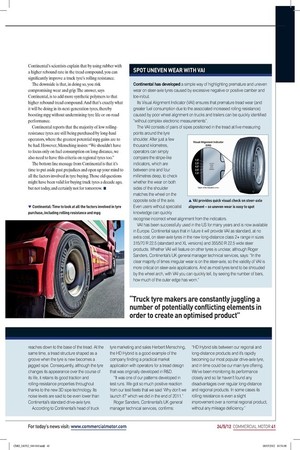Buying in the round
Page 31

Page 32

If you've noticed an error in this article please click here to report it so we can fix it.
With fuel costs sky high, Continental says it’s time to look beyond the ‘how much and for how long?’ questions when buying tyres
Words: Brian Weatherley
When Continental’s next-generation truck tyres eventually go on sale, they’ll offer hardpressed operators even greater fuel savings compared with the company’s current long distance product range, thanks to significant further reductions in rolling resistance. And there won’t be any compromises on wear-rates in order to achieve it.
The German tyre maker is already making bold claims on its future CV products, due to break cover by 2014, and in recent discussions with CM it also talked about its current products, including the latest HD Hybrid drive-axle tyre, rapidly gaining in popularity in the UK, and its VAI steer-axle wear indicator (see boxes). Meanwhile, as the price of diesel continues to rise, Continental insists operators need to take a broader, more holistic approach to tyre choice beyond the traditional ‘how much and how long will it last?’ questions. In particular, with the need to use less fuel pushing lower rolling-resistance higher up the buying agenda, Continental’s head of truck tyre marketing and sales Herbert Mensching says operators need to consider the fact that any additional on-cost experienced through the use of lower rolling-resistance products should be balanced against the opportunity of greater mpg cost savings. In short, operators need to consider all the factors in the tyre purchase equation if they’re to gain a truly aggregate ‘win’.
Optimised product
Mensching’s remarks underpin the fact that the truck tyre makers themselves are also constantly juggling a number of potentially conflicting elements in order to create an optimised product. Nowhere is that more aptly illustrated than in the search for ever-lower rolling-resistance. Continental’s scientists explain that by using rubber with a higher rebound rate in the tread compound, you can significantly improve a truck tyre’s rolling resistance.
The downside is that, in doing so, you risk compromising wear and grip. The answer, says Continental, is to add more synthetic polymers to that higher rebound tread compound. And that’s exactly what it will be doing in its next-generation tyres, thereby boosting mpg without undermining tyre life or on-road performance.
Continental reports that the majority of low rollingresistance tyres are still being purchased by long-haul operators, where the greatest potential mpg gains are to be had. However, Mensching insists: “We shouldn’t have to focus only on fuel consumption on long distance, we also need to have this criteria on regional tyres too.” The bottom line message from Continental is that it’s time to put aside past prejudices and open up your mind to all the factors involved in tyre buying. Those old questions might have been valid for buying truck tyres a decade ago, but not today, and certainly not for tomorrow. n










































